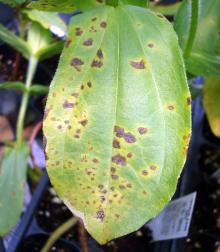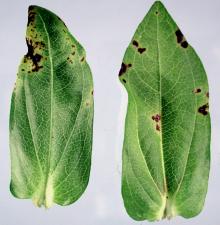See:
Cause Xanthomonas campestris pv. zinniae, a bacteria that can survive in dried zinnia leaves for as long as a year. They can reside on foliage for several months before initiating disease. The bacteria can also be seedborne contaminating the surface of the seed. Infected plant material is probably the most important source of contamination. Bacteria can be spread from plant to plant by splashing water from overhead or sprinkler irrigation. The disease spreads rapidly during warm, humid and rainy weather. Hot water soaks or antibiotics meant to clean the seed also reduced germination or were phytotoxic. There may be other experimental hosts but they have not been naturally infected.
Most common zinnia (Z. elegans) cultivars and Z. haageana are susceptible. The Crystal and Star series are highly resistant while the Profusion series are moderately resistant.
Symptoms Spots begin on lower leaves as dull gray water-soaked areas on the leaf. Numerous yellow or tan spots can develop across the leaf forming irregular dead areas. Often there is a yellow halo around individual lesions. Spots turn brown and angular which could then be confused with Alternaria leaf spot. Small brown spots may form on the ray flowers and if severe flower heads can be disfigured and completely decay.
Cultural control Practice strict sanitation and rigorous scouting to identify and remove infected plants in the early stages before the pathogen spreads.
- Start with pathogen-free seed. Seed can be treated with a dilute bleach solution (10%) for 15 to 30 minutes. Be sure to test a small batch of seed for sensitivity to these treatments.
- Plant resistant cultivars or species.
- Plants with leaf spots should be discarded. Diseased plant debris should be removed from the growing area.
- Workers should wash their hands after handling diseased plants or soil.
- Handling of wet foliage should be avoided.
- Minimize splashing when watering.
- Increase spacing between plants.
- Rotate plantings to different beds each year and choose open sunny sites.
Chemical control Bactericides are only marginally effective so focus on cultural control tactics.
- Badge X2 at 1.5 to 2 lb/A. Group M1 fungicide. 24-hr greenhouse reentry. O
- CuPRO 5000 at 1.5 to 2 lb/A. Group M1 fungicide. 48-hr reentry.
- EcoSwing at 1.5 to 2 pints/100 gal water. Group BM01 fungicide. 4-hr reentry. O
- Grotto at 0.5 to 2 gal/30 to 100 gal water/A. Group M1 fungicide. 4-hr reentry.
- Phyton 27 at 1.3 to 2.5 oz/10 gal water. May cause some phytotoxicity under slow drying conditions. Group M1 fungicide. 48-hr reentry.
Biological control
- Cease or Rhapsody (Bacillus subtilis strain QST 713) at 2 to 8 quarts/100 gal water. Active ingredient is a small protein. Efficacy in the Pacific Northwest is unknown although it was effective in one trial in Maryland. 4-hr reentry. O
- Stargus (Bacillus amyloliquefaciens strain F727) at 2 to 4 quarts/A plus a nonionic surfactant. Group BM02 fungicide. 4-hr reentry. O
- Triathlon BA (Bacillus amyloliquefaciens strain D747) at 0.5 to 6 quarts/100 gal water. Group BM02 fungicide. 4-hr reentry. O
Reference Sahin, F., Kotan, R., Abbasi, P.A., and Miller, S.A. 2003. Phenotypic and genotypic characterization of Xanthomonas campestris pv. zinniae strains. European Journal of Plant Pathology 109:165-172.



